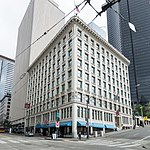Great Northern Tunnel

The Great Northern Tunnel is a 1-mile (1.6 km) double-tracked railway tunnel under downtown Seattle, Washington, completed by the Great Northern Railway in 1905, and now owned by the BNSF Railway, on its Scenic Subdivision. At the time it was built, it was the tallest and widest tunnel in the United States, at 28 feet (8.5 m) high and 30 feet (9.1 m) wide.The southern portal is just north of King Street Station, and the northern in Victor Steinbrueck Park, between Virginia and Pine Streets. The Downtown Seattle Transit Tunnel passes four feet below the Great Northern Tunnel. Freight and passenger trains use the tunnel, including Amtrak service to Chicago (the Empire Builder) and Vancouver, B.C. (Cascades), and Sound Transit's Seattle–Everett Sounder commuter rail service.
Excerpt from the Wikipedia article Great Northern Tunnel (License: CC BY-SA 3.0, Authors, Images).Great Northern Tunnel
Columbia Street, Seattle First Hill
Geographical coordinates (GPS) Address Nearby Places Show on map
Geographical coordinates (GPS)
| Latitude | Longitude |
|---|---|
| N 47.604 ° | E -122.333 ° |
Address
Chamber of Commerce Building
Columbia Street 215
98104 Seattle, First Hill
Washington, United States
Open on Google Maps









